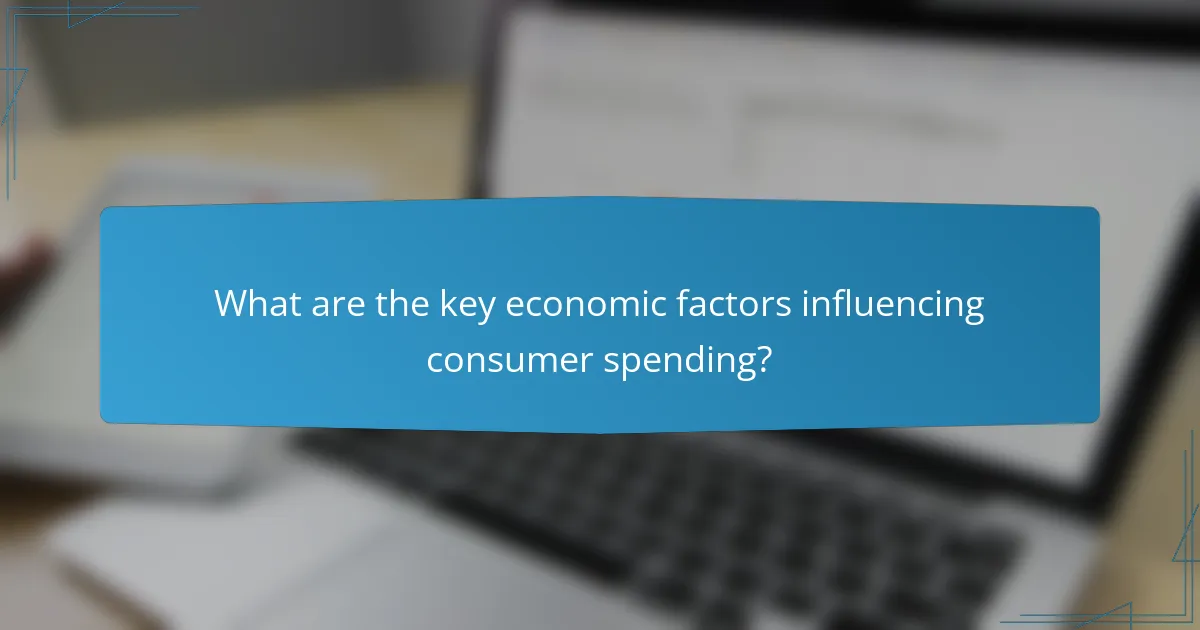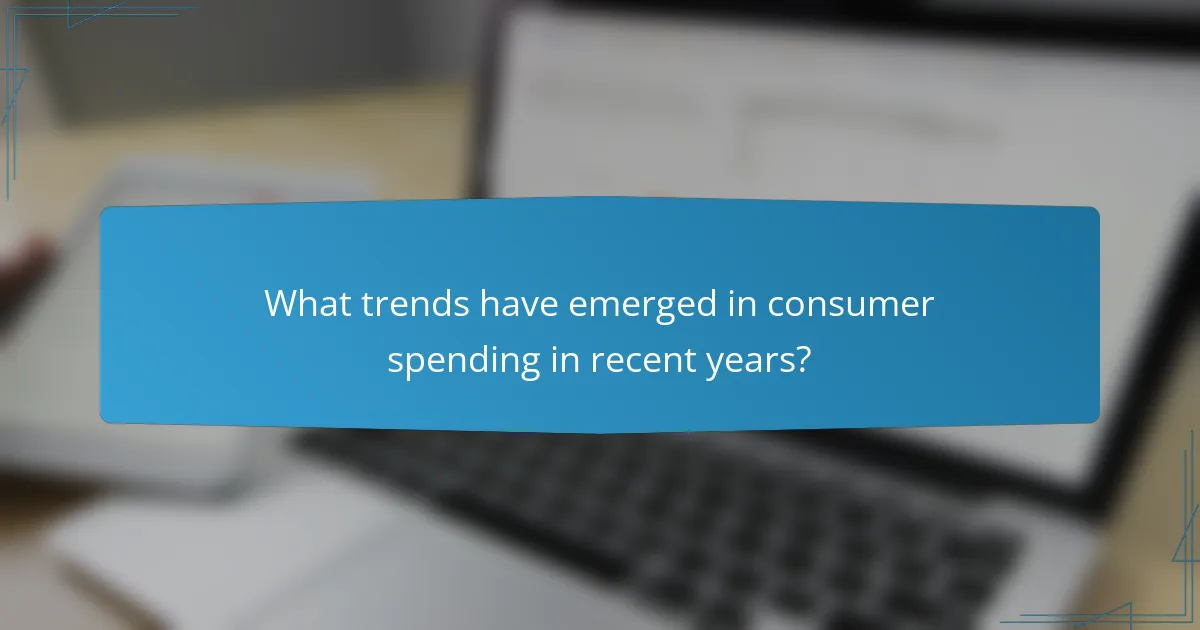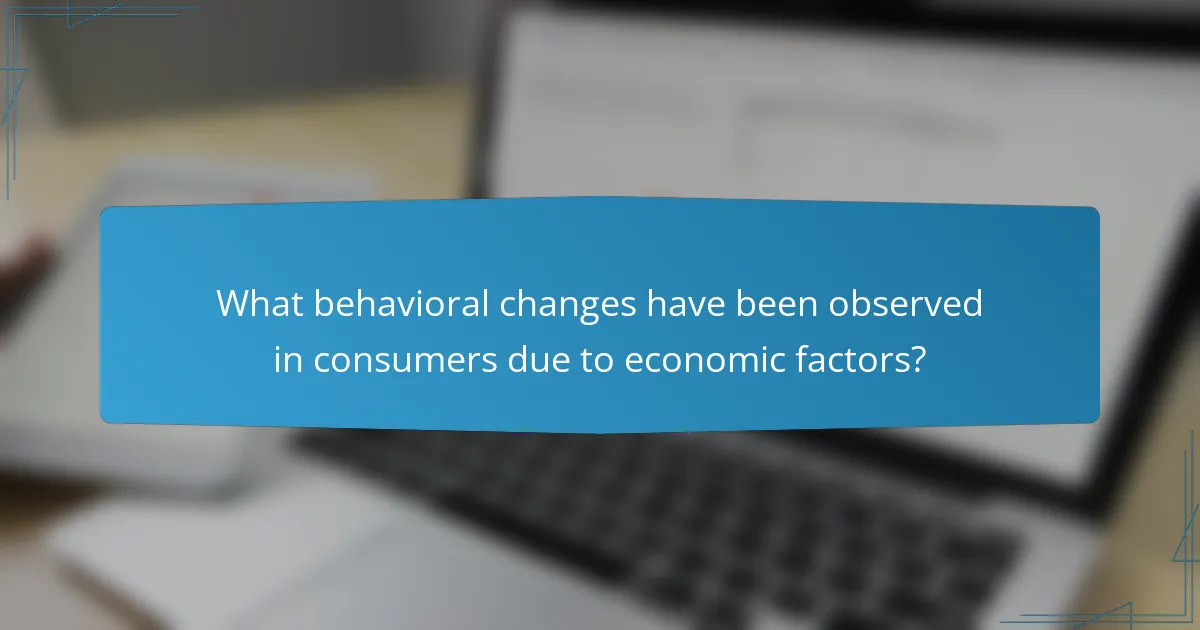The article investigates the role of economic factors in consumer spending, focusing on key influences such as income levels, employment rates, inflation, and interest rates. It highlights how these factors shape consumer behavior, including trends towards online shopping, prioritization of experiences over goods, and increased demand for sustainable products. The article also examines significant behavioral changes among consumers, such as a shift towards value-oriented brands and heightened price sensitivity during economic downturns. Overall, it provides a comprehensive overview of how economic conditions directly impact consumer spending patterns and decision-making processes.

What are the key economic factors influencing consumer spending?
The key economic factors influencing consumer spending include income levels, employment rates, inflation, and interest rates. Higher income levels generally lead to increased consumer spending. Employment rates impact disposable income and purchasing power. Inflation affects the cost of goods and services, influencing consumer choices. Interest rates determine the cost of borrowing, impacting spending on large purchases. For instance, a Federal Reserve report shows that lower interest rates often stimulate consumer spending by making loans cheaper.
How do inflation rates affect consumer purchasing behavior?
Inflation rates directly impact consumer purchasing behavior by reducing the purchasing power of money. As inflation increases, consumers face higher prices for goods and services. This often leads to changes in spending habits. For instance, consumers may prioritize essential items over luxury goods. A study by the Federal Reserve found that during periods of high inflation, consumer confidence typically declines. This decline in confidence can result in decreased overall spending. Additionally, consumers may seek discounts or substitute cheaper alternatives. Historical data indicates that inflation rates above 3% often correlate with reduced consumer spending growth.
What is the relationship between inflation and disposable income?
Inflation negatively impacts disposable income. As prices rise, the purchasing power of consumers decreases. This leads to less money available for discretionary spending. According to the Bureau of Labor Statistics, inflation rates have increased significantly in recent years. For instance, the Consumer Price Index rose by 7% in 2021. Consequently, households may find it challenging to maintain their previous spending levels. Reduced disposable income can lead to lower consumer spending, affecting overall economic growth.
How do consumers adjust their spending during inflationary periods?
Consumers adjust their spending during inflationary periods by prioritizing essential goods and services. They often reduce discretionary spending on non-essential items. This behavior is driven by rising prices, which erode purchasing power. Research indicates that during inflation, consumers tend to seek discounts and shop for lower-priced alternatives. A survey by the Federal Reserve in 2022 found that 70% of consumers reported changing their buying habits due to inflation. Furthermore, consumers may increase savings as a precaution against economic uncertainty. This shift reflects a broader trend of cautious financial management in response to inflationary pressures.
What role does unemployment play in consumer spending trends?
Unemployment negatively impacts consumer spending trends. When unemployment rates rise, disposable income decreases for many households. This leads to reduced consumer confidence and spending. According to the Bureau of Economic Analysis, a 1% increase in unemployment can decrease consumer spending by approximately 0.5%. Consumers tend to prioritize essential goods over discretionary purchases during high unemployment periods. This shift in spending behavior affects overall economic growth. Historical data shows that during the 2008 financial crisis, consumer spending fell significantly as unemployment surged. Therefore, unemployment plays a crucial role in shaping consumer spending patterns.
How does job security impact consumer confidence and spending?
Job security significantly influences consumer confidence and spending. When individuals feel secure in their jobs, they are more likely to spend money. This increased spending occurs because job security reduces anxiety about future income loss. A study by the Federal Reserve found that higher job security correlates with increased consumer spending. In contrast, job insecurity often leads to cautious spending behaviors. Consumers may prioritize savings over discretionary purchases when they fear job loss. This cautiousness can negatively impact overall economic growth. Thus, job security serves as a key driver of consumer confidence and spending patterns.
What are the effects of rising unemployment on discretionary spending?
Rising unemployment negatively impacts discretionary spending. As job loss increases, consumers face reduced income, leading to tighter budgets. Households prioritize essential expenses over non-essential items. For example, during the 2008 financial crisis, consumer spending on discretionary goods fell by 2.5%. This trend shows that higher unemployment correlates with decreased spending on luxury items, entertainment, and dining out. Additionally, research from the Bureau of Labor Statistics indicates that unemployment rates directly influence consumer confidence, further affecting spending behavior. Overall, rising unemployment results in a significant decline in discretionary spending.

What trends have emerged in consumer spending in recent years?
Recent years have seen significant trends in consumer spending. Increased online shopping has become a dominant behavior. According to the U.S. Department of Commerce, e-commerce sales grew by 32.4% in 2020. Consumers are prioritizing experiences over goods, with spending on travel and dining rising post-pandemic. Sustainability has also influenced spending, with 54% of consumers willing to pay more for eco-friendly products, as reported by Nielsen. Subscription services have gained popularity, with a 200% increase in usage in the last five years. Additionally, consumers are more price-sensitive, leading to a rise in discount shopping and brand switching. These trends illustrate a shift in consumer priorities and behaviors in response to economic conditions.
How have technological advancements influenced consumer spending habits?
Technological advancements have significantly influenced consumer spending habits by enhancing convenience and accessibility. Online shopping platforms allow consumers to purchase goods from anywhere at any time. Mobile payment systems, like Apple Pay and Google Wallet, simplify transactions. Social media marketing targets consumers effectively, driving impulse purchases. Data analytics enable personalized shopping experiences, increasing customer satisfaction. According to Statista, e-commerce sales reached $4.28 trillion in 2020, reflecting this shift. Additionally, the rise of subscription services has changed how consumers allocate their budgets. Overall, technology has reshaped the landscape of consumer spending.
What are the impacts of e-commerce on traditional retail spending?
E-commerce significantly reduces traditional retail spending. Online shopping offers convenience and often lower prices, attracting consumers away from physical stores. A study by the U.S. Department of Commerce indicated that e-commerce sales accounted for 14.3% of total retail sales in 2020, up from 10.8% in 2019. This shift leads to decreased foot traffic in brick-and-mortar stores. Retailers have reported lower sales figures as consumers prefer the ease of online transactions. Additionally, the COVID-19 pandemic accelerated this trend, with many consumers opting for online purchases over in-store shopping. Overall, e-commerce reshapes consumer behavior and spending patterns, negatively impacting traditional retail.
How do mobile payment options affect consumer purchasing decisions?
Mobile payment options significantly influence consumer purchasing decisions. They enhance convenience and speed during transactions. This immediacy often leads to increased impulse buying. A study by Statista found that 45% of consumers prefer mobile payments for their ease of use. Additionally, mobile payments can increase consumer trust due to enhanced security features. Research from the Federal Reserve indicates that consumers are more likely to complete purchases when mobile payment options are available. This accessibility encourages higher spending, particularly among younger demographics. Overall, mobile payment options create a more seamless shopping experience, directly impacting consumer behavior.
What demographic shifts are influencing consumer spending patterns?
Aging populations are significantly influencing consumer spending patterns. As the population ages, older adults tend to spend more on healthcare and wellness products. Millennials and Gen Z are prioritizing experiences over material goods, shifting spending towards travel and dining. Increased diversity in demographics is leading to varied preferences in product offerings. Urbanization is driving demand for convenience-based services and products. The rise of remote work is changing housing and commuting-related expenditures. Economic factors such as income inequality are also affecting spending habits. For instance, higher-income households are increasing their spending on luxury items while lower-income groups focus on essentials. These demographic shifts create a dynamic landscape for businesses to navigate.
How do millennials and Gen Z differ from previous generations in spending?
Millennials and Gen Z differ from previous generations in spending by prioritizing experiences over material goods. They often allocate their budgets towards travel, dining, and entertainment. According to a 2020 report by Deloitte, 72% of millennials prefer to spend on experiences rather than possessions. Additionally, Gen Z is more inclined to shop online, with 73% of them favoring digital purchases. This shift reflects a broader cultural trend valuing sustainability and minimalism. Millennials and Gen Z also exhibit a strong preference for brands that align with their social values. This focus on ethical consumption is supported by research from McKinsey, which found that 67% of consumers in these generations prefer sustainable brands.
What role does urbanization play in changing consumer preferences?
Urbanization significantly influences consumer preferences by shifting demographics and lifestyles. As populations move to urban areas, access to diverse products and services increases. Urban consumers tend to favor convenience, sustainability, and premium quality. Research indicates that urban dwellers often prioritize experiences over material goods. A study by the McKinsey Global Institute shows urban consumers are more likely to spend on health and wellness products. This trend reflects changing values towards quality of life. Urbanization also fosters exposure to global brands, shaping preferences for international products. These factors collectively drive a transformation in consumer behavior.

What behavioral changes have been observed in consumers due to economic factors?
Consumers have exhibited several behavioral changes due to economic factors. Increased prices often lead to reduced spending on non-essential items. During economic downturns, consumers tend to prioritize essential goods over luxury items. Many consumers shift towards value-oriented brands in response to financial constraints. Research shows that 60% of consumers reported buying more store-brand products during economic recessions. Additionally, consumers are more likely to delay major purchases, such as cars or homes, when economic uncertainty increases. Savings rates typically rise as consumers become more cautious about their financial futures. These changes reflect a direct correlation between economic conditions and consumer behavior.
How do consumers prioritize spending during economic downturns?
During economic downturns, consumers prioritize essential spending over discretionary expenses. They focus on necessities such as food, housing, and healthcare. Non-essential items, like luxury goods and entertainment, see reduced spending. This shift occurs as individuals aim to manage tighter budgets. Research shows that during the 2008 financial crisis, consumer spending on non-essentials dropped significantly. According to a study by the Bureau of Economic Analysis, essential goods maintained steady sales even in downturns. Consumers also seek discounts and promotions to stretch their budgets further. This behavior reflects a fundamental change in spending priorities during economic uncertainty.
What categories of goods see increased or decreased spending during recessions?
During recessions, spending on essential goods typically increases, while spending on luxury items decreases. Essential goods include food, household supplies, and healthcare products. Consumers prioritize these items when facing financial constraints. Conversely, luxury goods, such as high-end clothing and electronics, see a decline in sales. A study by the National Bureau of Economic Research indicates that discretionary spending drops significantly during economic downturns. Historical data from the 2008 financial crisis shows a marked decrease in luxury spending, while grocery sales remained stable or increased. This behavior reflects consumers’ shift towards prioritizing basic needs during tough economic times.
How do consumers adapt their saving and spending habits in response to economic stress?
Consumers adapt their saving and spending habits in response to economic stress by prioritizing essential expenditures and increasing savings. During economic downturns, they tend to cut back on discretionary spending. This behavior is often driven by uncertainty regarding future income and job security. Research indicates that 70% of consumers reduce non-essential purchases during such times. Additionally, consumers may seek to build emergency funds, leading to higher savings rates. A survey by the Federal Reserve found that 40% of Americans reported saving more due to economic concerns. These changes reflect a cautious approach to financial management amid economic challenges.
What strategies can consumers employ to manage spending effectively?
Consumers can manage spending effectively by creating a budget. A budget helps track income and expenses. It allows consumers to allocate funds for necessities and savings. Using budgeting apps can simplify this process. Consumers should also prioritize needs over wants. This strategy helps avoid impulse purchases. Additionally, setting spending limits for discretionary categories is beneficial. Regularly reviewing financial goals can reinforce spending discipline. Research indicates that consumers who budget save an average of 20% more than those who do not.
How can consumers make informed choices in volatile economic conditions?
Consumers can make informed choices in volatile economic conditions by conducting thorough research and analyzing market trends. They should stay updated on economic indicators, such as inflation rates and employment statistics. Understanding these factors helps consumers anticipate price changes and adjust their spending accordingly.
Additionally, comparing prices and seeking out discounts can enhance purchasing decisions. Utilizing budgeting tools allows consumers to track their expenses and prioritize essential purchases. Engaging with financial literacy resources can further empower consumers to understand their financial situation.
Studies show that consumers who actively seek information are more likely to make better financial decisions. For example, a report from the Federal Reserve indicates that informed consumers tend to save more and spend wisely during economic fluctuations.
What budgeting techniques are most effective for navigating economic fluctuations?
Effective budgeting techniques for navigating economic fluctuations include zero-based budgeting, the envelope system, and flexible budgeting. Zero-based budgeting requires justifying all expenses for each new period. This method helps prioritize spending based on current financial situations. The envelope system involves allocating cash for specific categories of spending. This technique encourages discipline and limits overspending. Flexible budgeting adjusts expenses based on actual revenue. It allows for real-time financial management during economic changes. These techniques have been shown to enhance financial resilience during economic downturns.
The main entity of this article is economic factors influencing consumer spending. The article explores key economic determinants such as income levels, employment rates, inflation, and interest rates, and their impact on consumer behavior and purchasing patterns. It discusses how inflation affects disposable income and spending habits, the role of unemployment in shaping consumer confidence, and recent trends in consumer spending, including the rise of e-commerce and changing demographic preferences. Additionally, it highlights strategies consumers can employ to manage their spending effectively amid economic fluctuations.